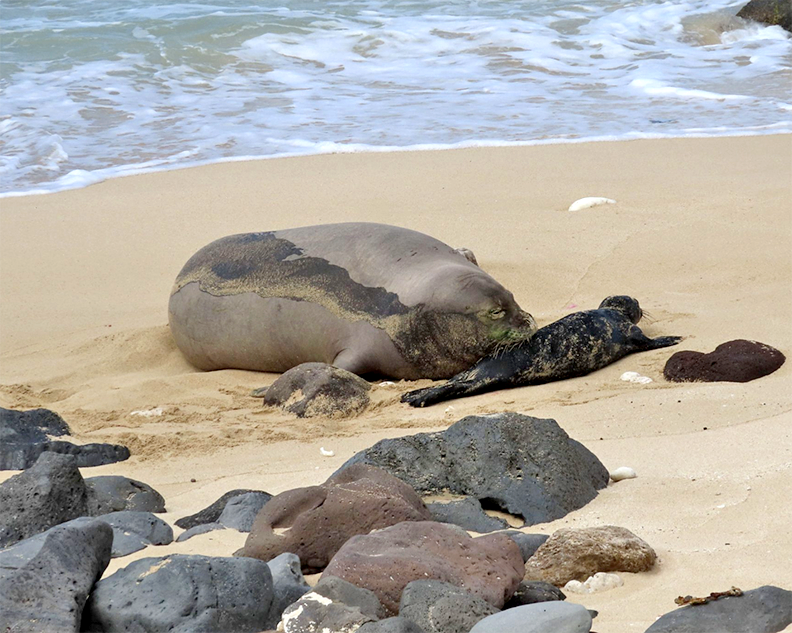By Ruby Pap

This graphic shows how carbon emissions into the atmosphere causes ocean acidification and impacts marine life. Source: Drupp et al. 2014
A couple years ago, I visited a global warming exhibit at a California aquarium and came across a huge mural of hundreds of beautiful pink jellyfish on a black background. The caption described a future ocean state in which these fleshy creatures would dominate if something wasn’t done to curb human-induced carbon emissions.
Seems straight out of a science fiction novel, huh? Not quite. Scientific data shows the oceans are becoming more acidic due to carbon dioxide emissions and it is fundamentally changing ocean chemistry and the ability for hard-shelled marine organisms to survive.
Long-term atmospheric measurements at Mauna Loa Observatory show carbon dioxide levels in the atmosphere since the industrial revolution have been increasing at alarming rates. At the same time, measurements of CO2 in deep seawater — taken at ‘Station Aloha’ at the North Pacific subtropical gyre near Hawai‘i since 1988 — show a similar increase and a corresponding decrease in pH levels (i.e. acidic).

Hawai‘i Carbon Dioxide Time Series: Correlation between rising levels of carbon dioxide detected at Mauna Loa Observatory with rising CO2 in the ocean at nearby Station Aloha. Source: NOAA PMEL Carbon Program http://www.pmel.noaa.gov/co2/. From Dore, J.E., R. Lukas, D.W. Sadler, M.J. Church, and D.M. Karl. 2009. Physical and biogeochemical modulation of ocean acidification in the central North Pacific. Proc Natl Acad Sci USA 106:12235-12240.
When CO2 is released into the atmosphere from things like the burning of fossil fuels and deforestation, the ocean absorbs about 1/3 of the excess carbon. Once considered a beneficial sink to absorb gasses that cause global warming, this process actually lowers the pH of ocean water by forming carbonic acid which causes a reduction in seawater pH. This is commonly referred to as ocean acidification. Seawater has natural protection mechanisms for this, but in the process of doing so, carbonate ions are consumed. These carbonate ions are the necessary ingredients for the creation of marine shells and skeletons made from calcium carbonate, including coral reefs.
Detection and characterization of ocean acidification in coral reef systems is very difficult, because baseline data on natural temporal and spatial changes in near reef carbonate chemistry is relatively new. Unlike the open ocean, coastal waters are subject to a host of inputs from the land and atmosphere, which also affect marine life and pH levels. In a reef environment, this includes river inputs, precipitation and evaporation, and advection to and from the open ocean. Further, a reef grows through the process of photosynthesis and respiration, which takes in and releases CO2 at different times and varying rates.
This is where research from the University of Hawai‘i School of Ocean and Earth Science and Technology comes in. Dr. Eric De Carlo and graduate students, building off research by Dr. Fred Mackenzie, are using monitoring buoys in the waters off of Kane‘ohe Bay to examine the processes that affect the health of coral reefs, including CO2.
The data appears to show an increase in concentration of CO2 in reef waters over the last six years, particularly at night, when reef respiration releases CO2 into the water. In addition, PH levels in sea floor sediments have been acidic enough to start dissolving calcium carbonate formed by shells (dissolution). However, during the day, calcium carbonate is still being produced (calcification). The key research question is what the healthy balance between calcification and dissolution is, and at what point the balance will tip in the negative direction. Additional resources ($$$) are needed to maintain and expand this important work.
What is clear is that global CO2 levels are rising and the ocean is becoming more acidic. The only way to stop this is to lower emissions. This is the major negotiating point in the U.N. Framework Convention on Climate Change, which will hopefully culminate in a meaningful agreement next December in Paris. These efforts, along with changes in our own consumptive behavior should be strongly encouraged!
- Ruby Pap is a Coastal Land Use Extension Agent at University of Hawai‘i Sea Grant College Program. She can be reached at rpap@hawaii.edu.
Discover more from ForKauaiOnline
Subscribe to get the latest posts to your email.





Leave a Reply